If you read the last post, you know what’s going on. This is the second part of my list of essential comics that serve as the best possible gateway into grasping the overall Batman meta-narrative. This week, I’m highlighting post-Crisis works:
11.‘Batman: Year One’ (Batman #404-407, cover-dated February-May 1987), by Frank Miller (script), David Mazzucchelli (art), Richmond Lewis (colors), Todd Klein (letters)
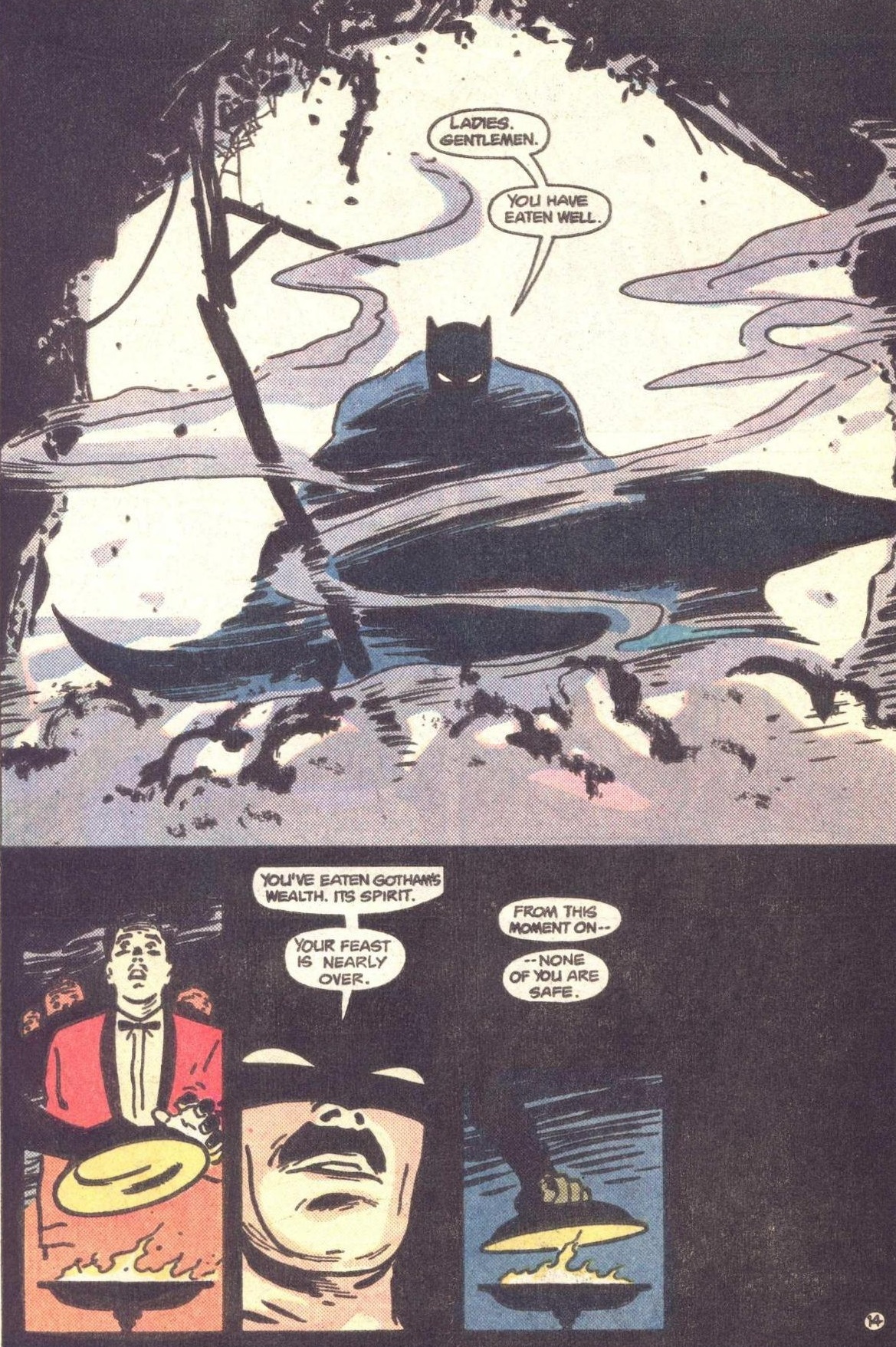
The second of Frank Miller’s one-two punch assault on Batman comics (and on the medium as a whole), Year One replaced DKR’s operatic scale with a restrained, grounded account of the Dark Knight’s first year in Gotham City. Between Miller’s tense prose and David Mazzucchelli’s grimy art, this is probably the closest anyone has ever come to pulling off a rendition of Batman that truly reads like a straight-up, hardboiled crime yarn (with the possible exception of ‘Death Strikes at Midnight and Three,’ as mentioned last week). I discussed this story-arc here, including the following passage: ‘Starting with a young Bruce Wayne’s return to Gotham after having trained around the world, the book covers the roughly one year period in which Bruce develops his Batman identity, giving us a glimpse of his learning curve as he first tackles the city’s organized crime and rampant corruption. Composed mostly of short vignettes intercut with a few long sequences, Year One is more character study than conventional plot. In an inspired decision, we don’t just get to follow Batman’s growth, but that of Lieutenant James Gordon, who is almost as much a main character as Bruce. Both are fighting for (and against) the city, but one from outside the law and the other from within, one from a position of privilege and the other under constant threat – until they finally join forces when they realize they can hardly trust anyone but each other…’ (This book was so popular that it spanned the whole subgenre of ‘Year One’ comics.)
12.‘The Killing Joke’ (The Killing Joke, cover-dated 1988), by Alan Moore (script), Brian Bolland (art), John Higgins (colors), Richard Starkings (letters)
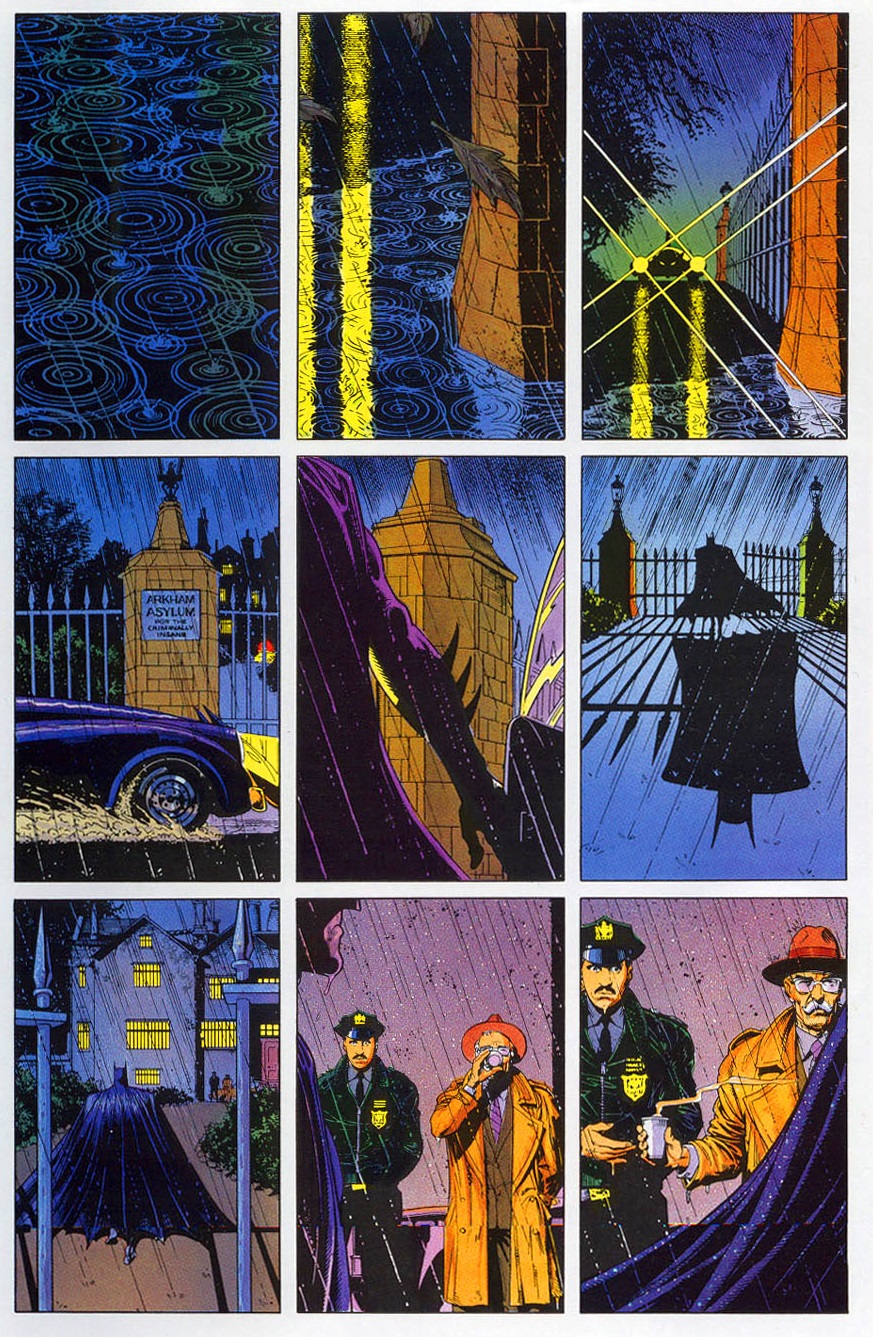
As sympathetic as I am with the critical readings of The Killing Joke that have stressed its place in the tradition of brutalizing female characters just to advance the characterization of male protagonists, I still cannot fully bring myself to claim this prestige one-shot is not some kind of masterpiece. Alan Moore has certainly written better comics, but this remains a fluid tale – with gorgeous art by Brian Bolland – where every image and line of dialogue resonates with decades of history between Batman and the Joker. In How to Read Superhero Comics and Why, Geoff Klock perceptively explores some of the various layers, setting up the discussion like this: ‘While The Dark Knight Returns shows order from the perspective of Batman, The Killing Joke shows both the terror and the peculiar joyfulness of living within a fictional world burdened by an insanity of signification, and the anxiety caused by contradictory influence and overdetermination. It takes its place in the initial phase of the revisionary superhero narrative in that it exposes the construction of its own narrative, and superhero narratives in general, through several key reflexive moments and metaphors. The image with which the story opens (and to which it fades) is that of the concentric rings created by raindrops in a shallow puddle. […] The randomly falling raindrops that create lesser or greater waves upon the puddle’s surface stand for individual superhero stories and their effect on the field of storytelling. […] Shallow but broad, the puddle emphasizes the tradition or field of signification from which The Killing Joke emerges. As the last image, it points to where any Batman work will end up – just another drop in the pond, another arbitrary center of organization that will reverberate into the character’s fictional history to greater or lesser effect.’
13.‘Arkham Asylum: A Serious House on Serious Earth’ (Arkham Asylum, cover-dated October 1989), by Grant Morrison (script), Dave McKean (art), Gaspar Saladino (letters)

Grant Morrison’s and Dave McKean’s contribution to the movement to push Batman comics into a more mature, sophisticated direction, this acclaimed graphic novel has the Dark Knight wander around Arkham Asylum and confront revised iterations of his villains, who act as allegories for notions of sanity and different mythological traditions. I do think there is merit to this work (for example, McKean’s painted art is suitably nightmarish), even though I wasn’t very generous when I brought it up here, relating it to Tim Burton’s films. Nikolai Fomich has a more thought-provoking take on the book here, which begins by addressing the sexual undertones of the rogues’ gallery: ‘These emblematic villains bring into the Batman universe different kinds of sexual queerness – not merely non-normative kinds of sexuality, some kinds of which (such as homosexuality) are often symbolically associated with good within Batman narratives, but rather various kinds of queerness that are destructive – the Mad Hatter’s brainwashing of young girls and pedophilia; Clayface III’s agalmatophili, or love of (female) mannequins, a love which he sometimes forgoes when he feels the urge to touch real human beings, a touch which turns them into clay; Joker’s anarchic and nihilistic egotism, which at times takes the form of a predatory sexuality; Two-Face’s repression of all his rage and aggression, arguably sexual in part; Maxie Zeus’ masturbatory obsession, steaming from his ego and delusional belief that he is a transvestite god who comprises both sexes; and Killer Croc’s vaginal deformation, symbolic for the wet, dark, and ravenous Dragon of legend and religion, representative of the “danger” and voraciousness of female sexuality. Batman’s relationship to these various mad villains is symbolically indicative of his own psychosexual health. Whether he fears them, relates to them, or defeats them in a story is important in understanding what authors and artists are saying in those texts about Batman’s psychologically and sexuality.’
14.‘A Death in the Family’ (Batman #426-429, cover-dated December 1988-January 1989), by Jim Starlin (script), Jim Aparo (pencils), Mike DeCarlo (inks), Adrienne Roy (colors), John Costanza (letters)
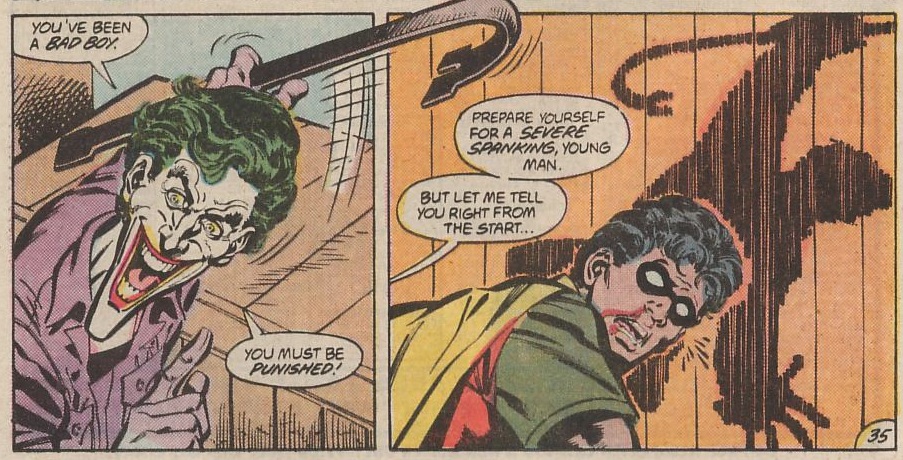
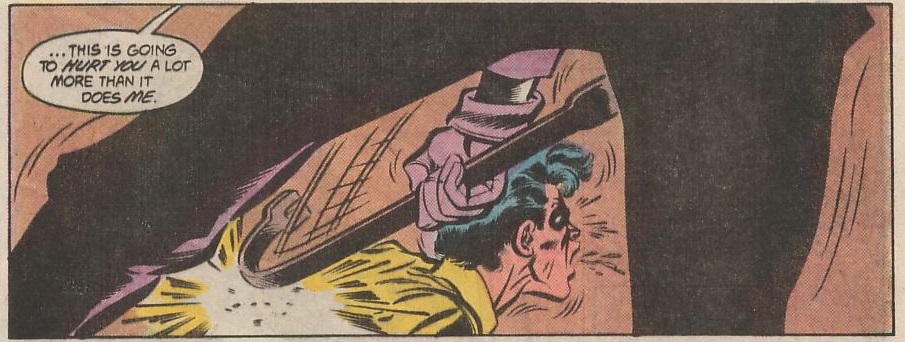
Another ultra-gritty, Joker-centric tale from the late ‘80s – yet this one doesn’t aim towards highbrow literature. Instead, A Death in the Family is like a distillation of the decade’s schlockiest blockbusters, complete with bloody macho action, Arab terrorists, globetrotting adventure, and an over-the-top climax in which the Dark Knight has to face the Joker’s diplomatic immunity (because the Clown Prince of Crime somehow became an Iranian ambassador). This Reaganite time capsule earned its place in the history of Batman comics not just because it revolved around the possibility of killing off the second Boy Wonder (Jason Todd), but because it infamously decided the story’s outcome via a 900 telephone number voting system, through which readers sealed the fate of the young character! Moreover, the Joker’s actions in this tale and in The Killing Joke pretty much defined his relationship with Batman for the following decades. That said, it’s a shame A Death in the Family is the first Jim Aparo-drawn entry on the list, as his pencils here pale in comparison to his earlier work. (Aparo’s lengthy run with Bob Haney on The Brave and the Bold is certainly an influential classic, but there isn’t any specific issue or set of issues that left an outstanding mark… The team-ups with Sgt. Rock are memorably bonkers, but you can just as easily pick up any other story to get a sense of that run.)
15.‘Knightfall’ (Batman #489-514, Batman Annual #17, Batman/Punisher: Lake of Fire, Catwoman (v2) #1-13, Detective Comics #659-681, Detective Comics Annual #6, Justice League Task Force #5-6, Legends of the Dark Knight #59-63, Mitefall, Punisher/Batman: Deadly Knights, Robin (v4) #1-13, Robin Annual #2, Shadow of the Bat #16-34, Showcase ’93 #7-12, Showcase ’94 #3-10, and Vengeance of Bane, cover-dated January 1993-January 1995), by Doug Moench, Dennis O’Neil, Jo Duffy, Chuck Dixon, Alan Grant, John Wagner (script), Jim Aparo, Norm Breyfogle, Mike Manley, Jim Balent, Mike Gustovich, Ron Wagner, Eduardo Barreto, Barry Kitson, Graham Nolan, Lee Weeks, Sal Velluto, Kevin O’Neill, John Romita Jr, Tom Grummett, Phil Jimenez, John Cleary, Kieron Dwyer, Bret Blevins, Vince Giarrano, John Beatty, Mark Bright, Klaus Janson, Bill Willingham, Bob McLeod, Tim Sale, P. Craig Russell, Michael T. Gilbert, Teddy Kristiansen, Mike Vosburg (pencils), Jim Aparo, Norm Breyfogle, Tom Mandrake, Bob Wiacek, Joe Rubinstein, Dick Giordano, Rick Burchett, Scott Hanna, Terry Austin, Mike Manley, Frank McLaughlin, Romeo Tanghal, Eduardo Barreto, James Pascoe, Ande Parks, Bob Smith, Bob McLeod, Klaus Janson, Gerry Fernandez, Jeff Albrecht, Ron McCain, Kevin O’Neill, Ray Kryssing, John Stokes, Jose Luis Garcia-Lopez, Carlos Pedrazzini, Steve George, Vince Giarrano, Bob McLeod, Jimmy Palmiotti, Bruce Patterson, Peter Gross, P. Craig Russell, Michael T. Gilbert, Teddy Kristiansen (inks), Adrienne Roy, Matt Hollingsworth, Buzz Setzer, Glenn Whitmore, Christie Scheele, Klaus Janson, Tom McCraw, Bernie Mireault, Lovern Kindzierski, Teddy Kristiansen, Dave Hornung (colors), Jim Aparo, Richard Starkings, Tim Harkings, Ken Bruzenak, Willie Schubert, Albert DeGuzman, Bob Pinaha, John Costanza, Clem Robins, Albert DeGuzman, Todd Klein, Bill Oakley (letters)
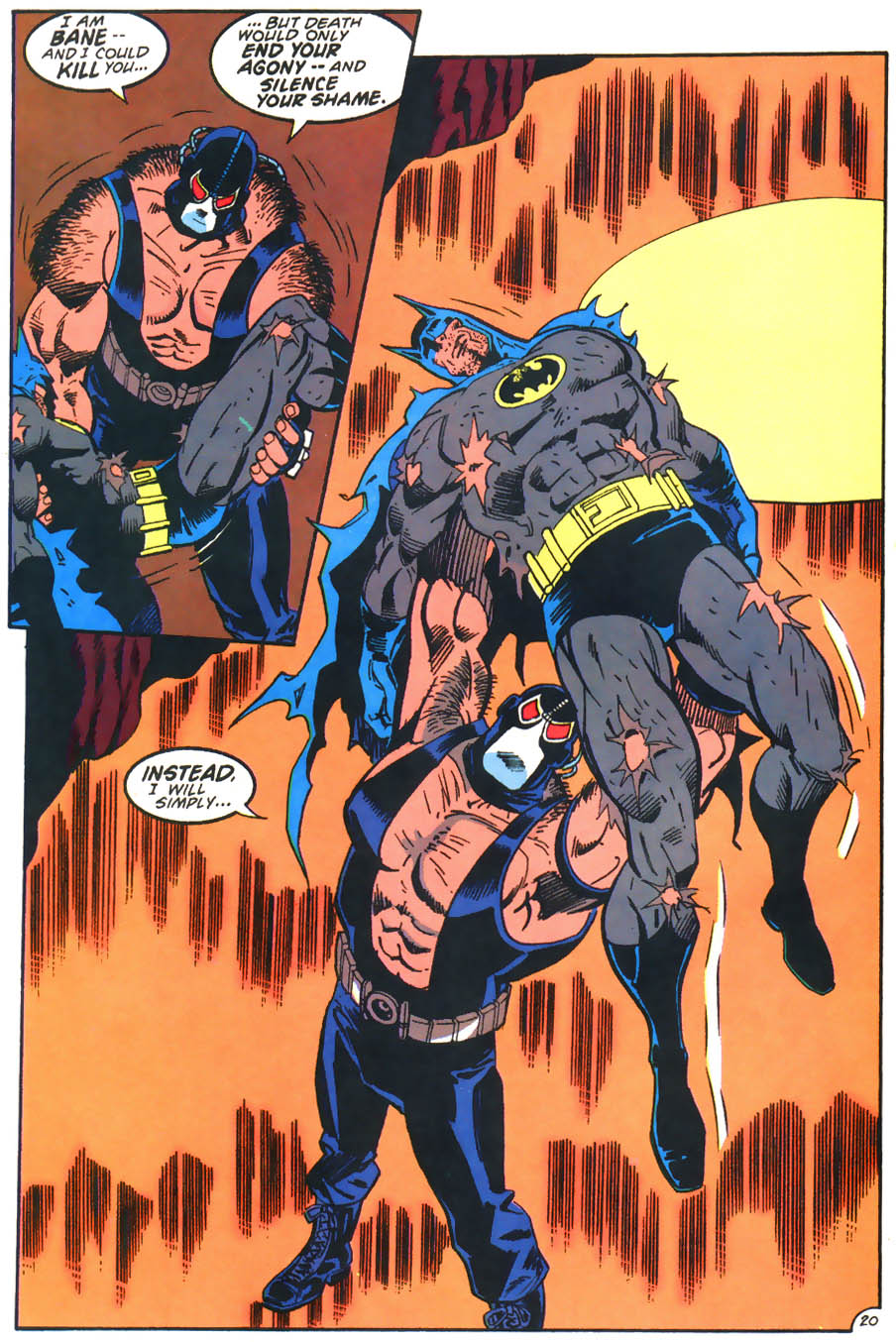
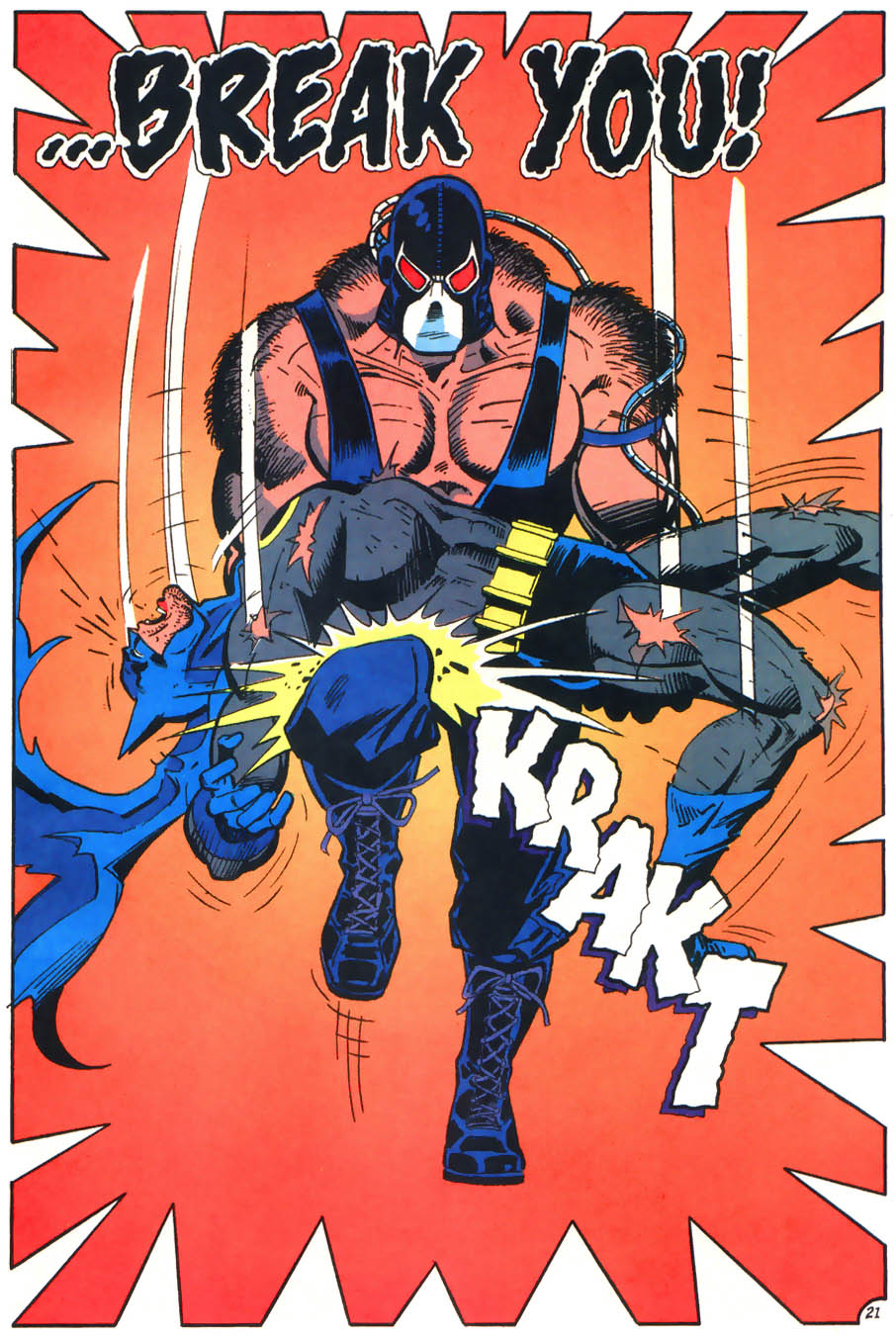
The output of DC comics in the ‘90s was marked by earth-shattering events (Superman’s death, Hal Jordan’s transformation into Parallax, etc), usually at the center of ambitious crossovers. Batman comics were no exception, with group editor Denny O’Neil coordinating a handful of different series, by different creators, into a coherent overarching narrative coming out weekly over long periods of time (in some cases, for over a year). To get a feel for the era, every fan should check out – at least partially – one of these sagas, with Knightfall being the most obvious candidate (together with its epilogue, Prodigal). In this crossover, the villain Bane (created specifically for the story) broke Batman’s spine, so Bruce Wayne was replaced by Jean Paul Valley, a super-violent psychopath with a bulging armored suit. The whole thing worked as an exciting-if-uneven epic at the surface level, but there was a metafictional subtext as well, with various characters – and, presumably, the readers – facing the fact that the old-school Caped Crusader was much cooler than the grim, bulky cyborg anti-heroes who were all the rage in comics at time. Knightfall (which has been collected in multiple editions) looms over the nineties – since mid-1992, most issues built up to the crossover; in its aftermath, key relations between characters were lastingly defined by what had transpired in that tale. This bombastic meta-series is also a chance to get acquainted with the decade’s most prolific creators (such as writers Doug Moench, Chuck Dixon, and Alan Grant, artists Norm Breyfogle and Graham Nolan, colorist Adrienne Roy, and cover-artist Kelley Jones), who shaped Batman’s world for years to come.
16.’The Long Halloween’ (The Long Halloween #1-13, cover-dated December 1996-December 1997), by Jeph Loeb (script), Tim Sale (art), Greg Wright (colors), Richard Starkings (letters)
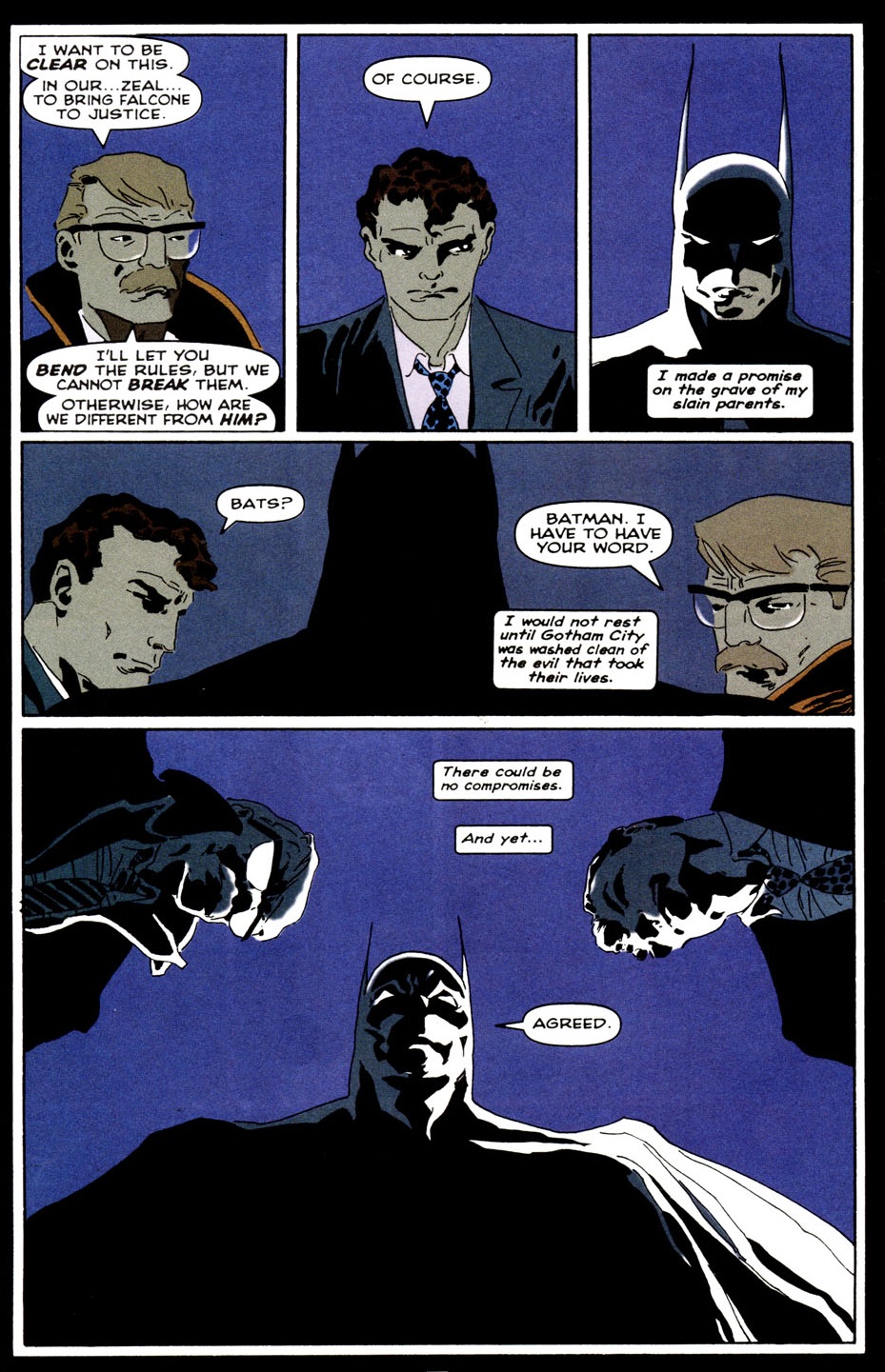
Of the many sequels to Batman: Year One, this is the one that stood above the crowd and made the most remarkable impression, smoothly bridging the gap – both storywise and stylistically – between the more realistic Miller/Mazzucchelli version of Gotham and the wilder version you find in most comics. When I wrote about it here, I put it this way: ‘This comic, which was a major inspiration for [Christopher] Nolan’s The Dark Knight, addresses the transformation of Gotham from a city of gangsters into a city of insane, costumed criminals, while also serving as an origin story for Two-Face. The Long Halloween picks up threads from Year One and has a similarly hardboiled atmosphere, although [Tim] Sale’s gorgeously stylized artwork gives it a very different flow from Mazzucchelli’s pencils – for one thing, Bruce Wayne looks less like a young Gregory Peck and more like someone who could knock out Arnold Schwarzenegger. More importantly, the book is full of taut characterization (particularly of Batman, Gordon, and district attorney Harvey Dent), shameless homages to The Godfather films, perhaps one too many gratuitous cameos by the rogues’ gallery, and a genuinely clever whodunit.’
17.‘No Man’s Land’ (Azrael, Agent of the Bat #50-61, Batman #563-574, Batman – Day of Judgment, Batman: Harley Quinn, Catwoman #66-77, Day of Judgment #1-5, Detective Comics #730-741, Hitman #37-46, JLA #32-33, Legends of the Dark Knight #116-126, Nightwing #32-39, No Man’s Land #0-1, Robin #67-73, Shadow of the Bat #83-94, The Batman Chronicles #16-18, Young Justice – No Man’s Land, cover-dated March 1999-February 2000. See the reading order here.), by Dennis O’Neil, Bob Gale, Devin Grayson, Greg Rucka, Kelley Puckett, Janet Harvey, Bronwyn Carlton, Chuck Dixon, Scott Beatty, Dafydd Wyn, Paul Dini, John Ostrander, Geoff Johns, Larry Hama, Garth Ennis, Mark Waid, Ian Edginton, Steven Barnes, Jordan B. Gorfinkel, Lisa Klink (script), Roger Robinson, Alex Maleev, Dale Eaglesham, Frank Teran, Jon Bogdanove, Damion Scott, Dan Jurgens, Sergio Cariello, Mike Deodato, Mat Broome, Sergio Cariello, Jason Pearson, Chris Renaud, Pascal Alixe, Eduardo Barreto, Graham Nolan, Dean Zachary, Yvel Guichet, Jim Balent, Matt Smith, Christopher Jones, Wayne Faucher, Frank Teran, Phil Winslade, Mike Deodato, Tom Morgan, John McCrea, Mark Pajarillo, D’Israeli, Rick Burchett, Paul Gulacy, Paul Ryan, Rafael Kayanan, Scott McDaniel, Greg Land, Staz Johnson, Gordon Purcell, N. Steven Harris, Guy Davis, Jason Minor, Pablo Raimondi, Andy Kuhn (pencils), James Pascoe, Wayne Faucher, Jaime Mendoza, Frank Teran, Eduardo Barreto, John Floyd, Bill Sienkiewicz, Matt Ryan, David Roach, Sean Parsons, John Floyd, Mark Pennington, Cam Smith, Wayne Faucher, Sal Buscema, Eduardo Barreto, Bill Sienkiewicz, Jaime Mendoza, Robert Campanella, Aaron Sowd, John Stanisci, Marlo Alquiza, Steve Mitchell, Frank Teran, Phil Winslade, David Roach, Rob Hunter, Garry Leach, Walden Wong, Matt Banning; Aaron Sowd, D’Israeli, James Hodgkins, Randy Eberling, Andy Lanning, Mark McKenna, Karl Story, Drew Geraci, Stan Woch, Marlo Alquiza, Guy Davis, Randy Emberlin, Chris Ivy (inks), Demetrius Bassoukos, Dave Stewart, Noelle Giddings, Gloria Vasquez, Richard Horie; Tanya Horie, Greg Wright, Noelle Giddings, Pamela Rambo, Patricia Mulvihill, Ian Laughlin, Rob Schwager, Tanya Horie; Richard Horie, Roberta Tewes, James Sinclair, Greg Wright, Carla Feeny, Pat Garrahy, John Kalisz, D’Israeli, Bob Schwager, Felix Serrano, Klaus Janson, Digital Chameleon, Adrienne Roy, Jason Wright (colors), Ken Bruzenak, Rob Ro; Alex Bleyaert, Willie Schubert, Todd Klein, John Costanza, Bill Oakley, Rick Parker, Clem Robins, Ken Lopez, Albert DeGuzman, Tim Harkins, Ellie DeVille, Patricia Prentice (letters)
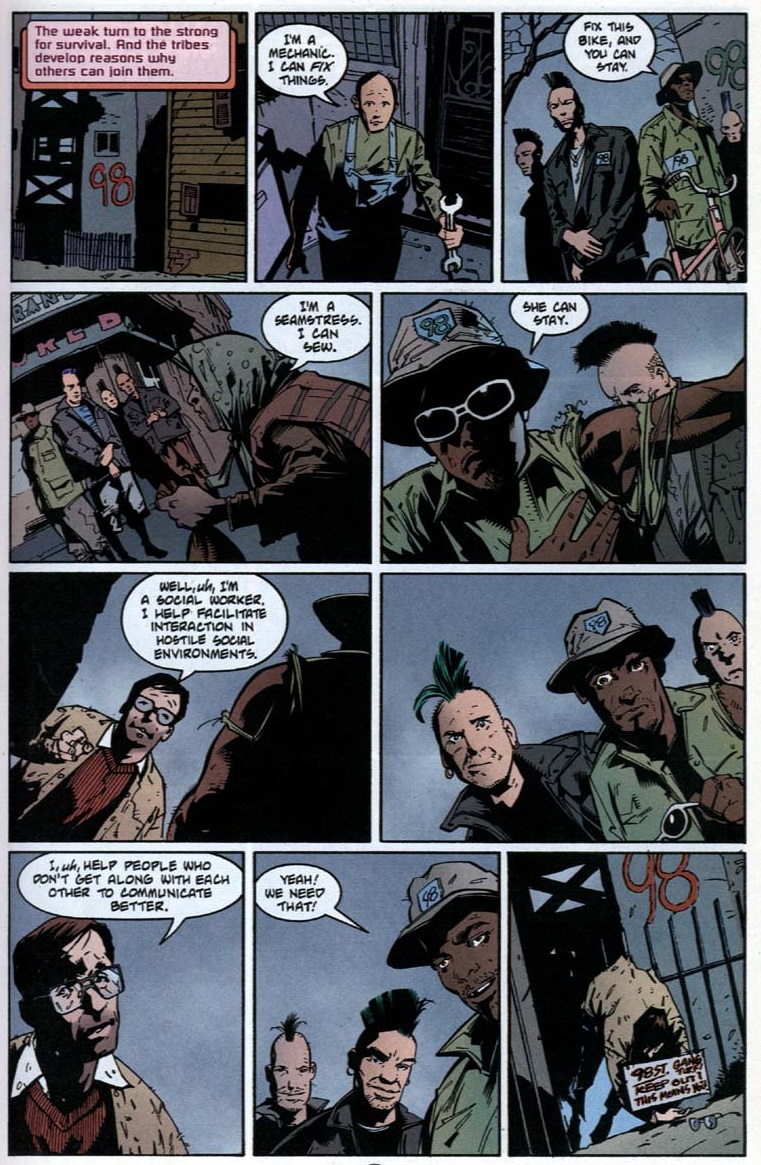
Another fundamental crossover – the one that closed the nineties and ushered in a new era of Batman comics (which included regular callbacks to the events in No Man’s Land). Above all, this is an essential work for those interested in the Dark Knight’s supporting cast and surrounding world, as it takes place after an earthquake destroyed Gotham and the government isolated the city from the rest of the United States, which allowed creators to play with various post-apocalyptic tropes. You get to see the people who stayed behind – the cops, the outlandish villains, the average citizens – reinvent civilization, including new variations of language and technology, as well a new hierarchy of value (‘a box of matches is more valuable than a camera, and a bike is more useful than a Ferrari’). Sprawling sagas are always hit-and-miss, but overall there is some genuinely engaging storytelling in this one. The more completist among you will want to go further and read about the earthquake, in Cataclysm, and other tales leading up to the government’s drastic decision, many of them collected in the Road to No Man’s Land paperbacks (see a comprehensive reading order here). If you find the prospect of reading over a hundred issues too intimidating, though, at least track down NML’s highest points (listed here).
18.‘Tower of Babel’ (JLA #43-46, cover-dated July-October 2000), by Mark Waid (script), Howard Porter, Steve Scott (pencils), Drew Geraci, Mark Propst (inks), Pat Garrahy, John Kalisz (colors), Ken Lopez (letters)
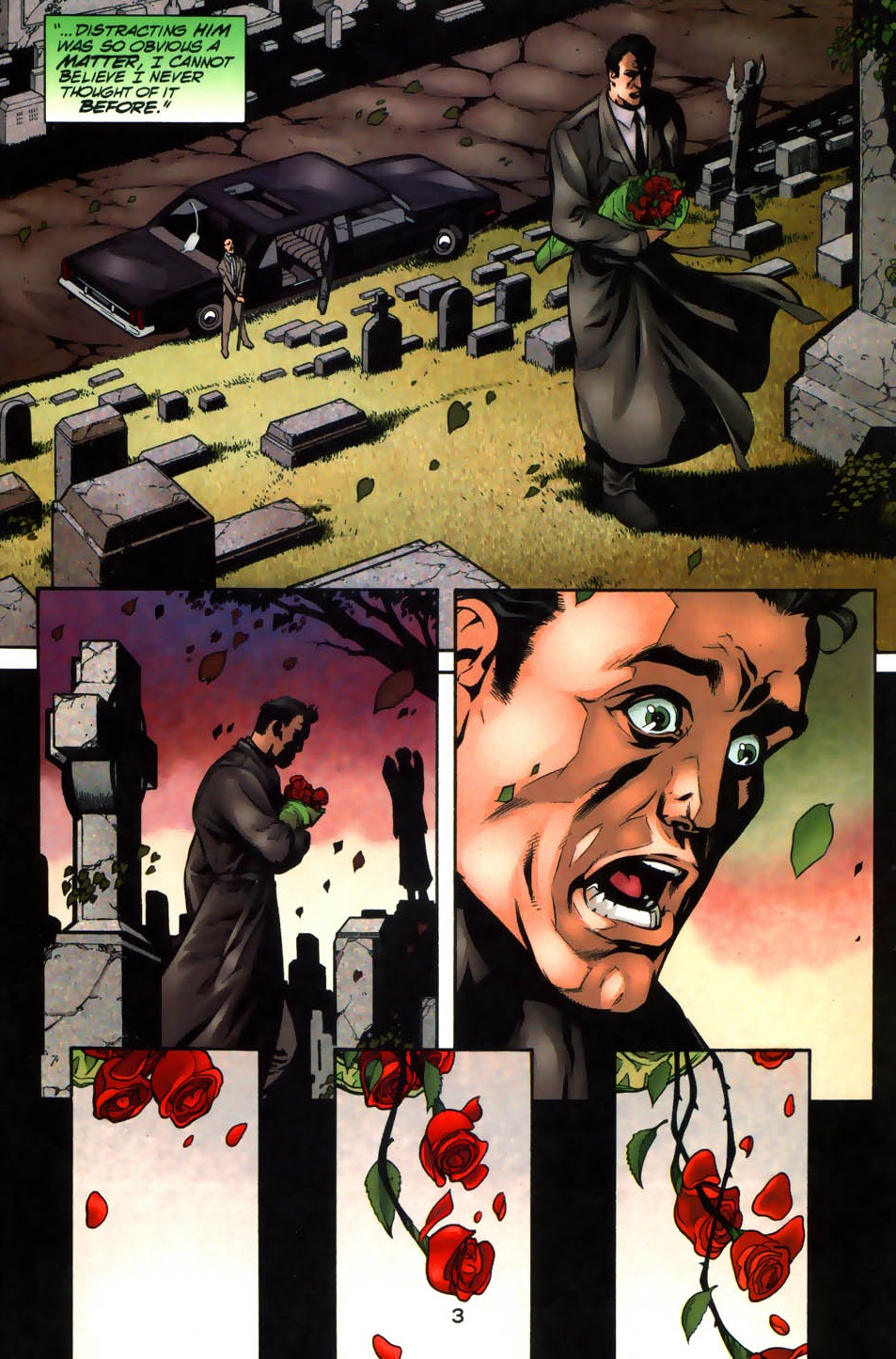
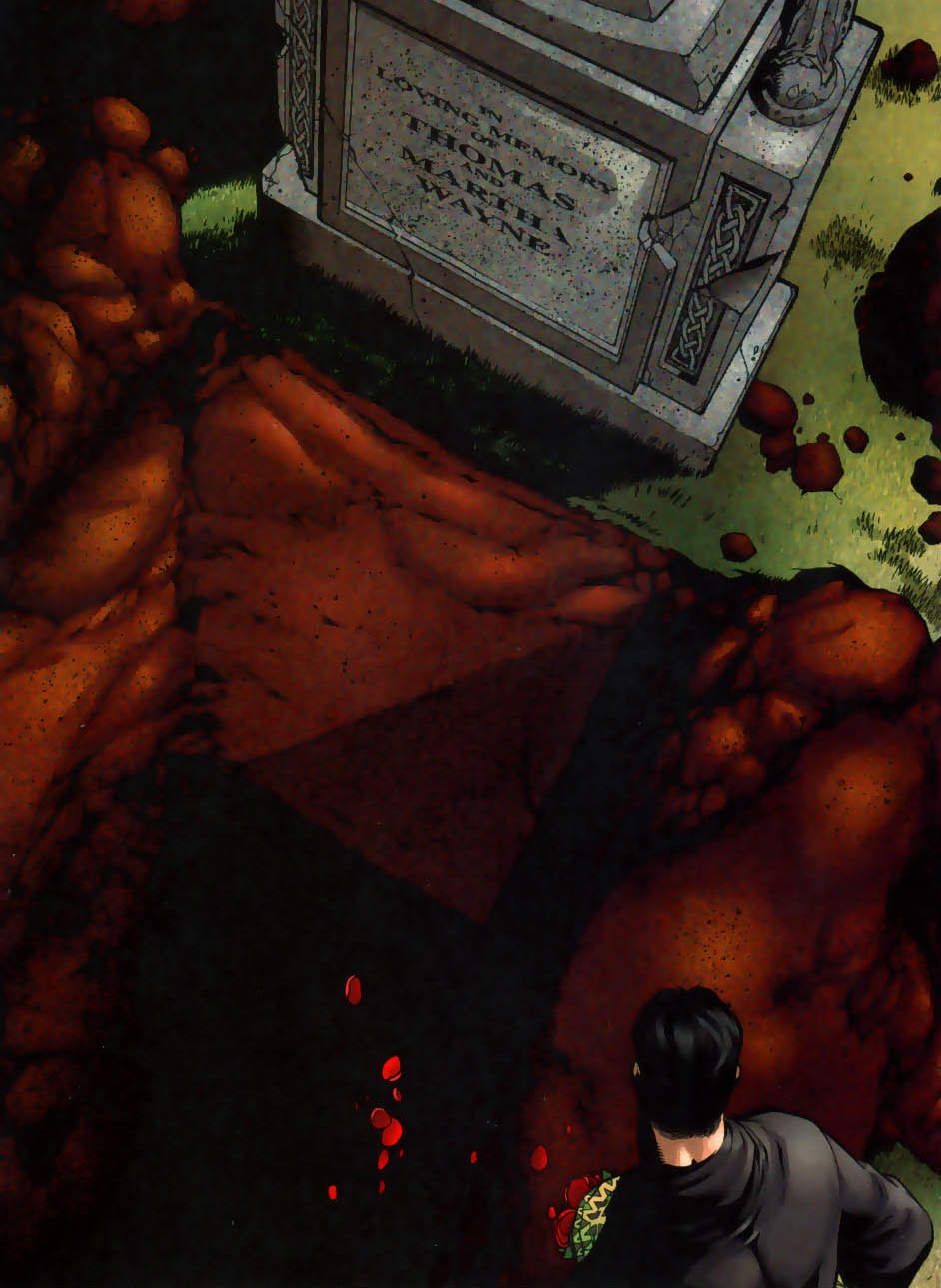
A solid understanding of the history of Batman comics has to take into account that, even though some choose to treat the character as a street-level ninja detective or vigilante, he is also firmly embedded in the world/genre of superheroes… and you can’t get a purer superhero yarn than Tower of Babel, from the frenetic pace of Mark Waid’s script down to Howard Porter’s exaggerated art style. It’s fairly easy to spot the roots of this story-arc in which the Dark Knight shows that he could theoretically defeat all the members of the Justice League of America. There is a clear line from the Batman vs Superman slugfest in DKR and from Grant Morrison’s reinvention of Bruce Wayne as an almost godlike, hyperintelligent planner who is *always* the most badass in the room (an approach Morrison prominently inaugurated in JLA’s early issues) until Tower of Babel, which took to the extreme the notion that this non-powered human was actually a match for some of the most powerful superhumans in the DC Universe. Yet the latter isn’t just an entertaining take on geeky discussions of the who-would-win-in-a-fight variety – this story left its own mark in the field, engraining the view that Batman was a paranoid douchebag who inevitably pushed away those closest to him (a view that dominated DC comics in the early years of the 21st century).
19.‘Batman and Son’ (Batman #655-658, cover-dated September-December 2006), by Grant Morrison (script), Andy Kubert (pencils), Andy Kubert, Jesse Delperdang (inks), Dave Stewart, Guy Major (colors), Nick J. Napolitano, Rob Leigh (letters)
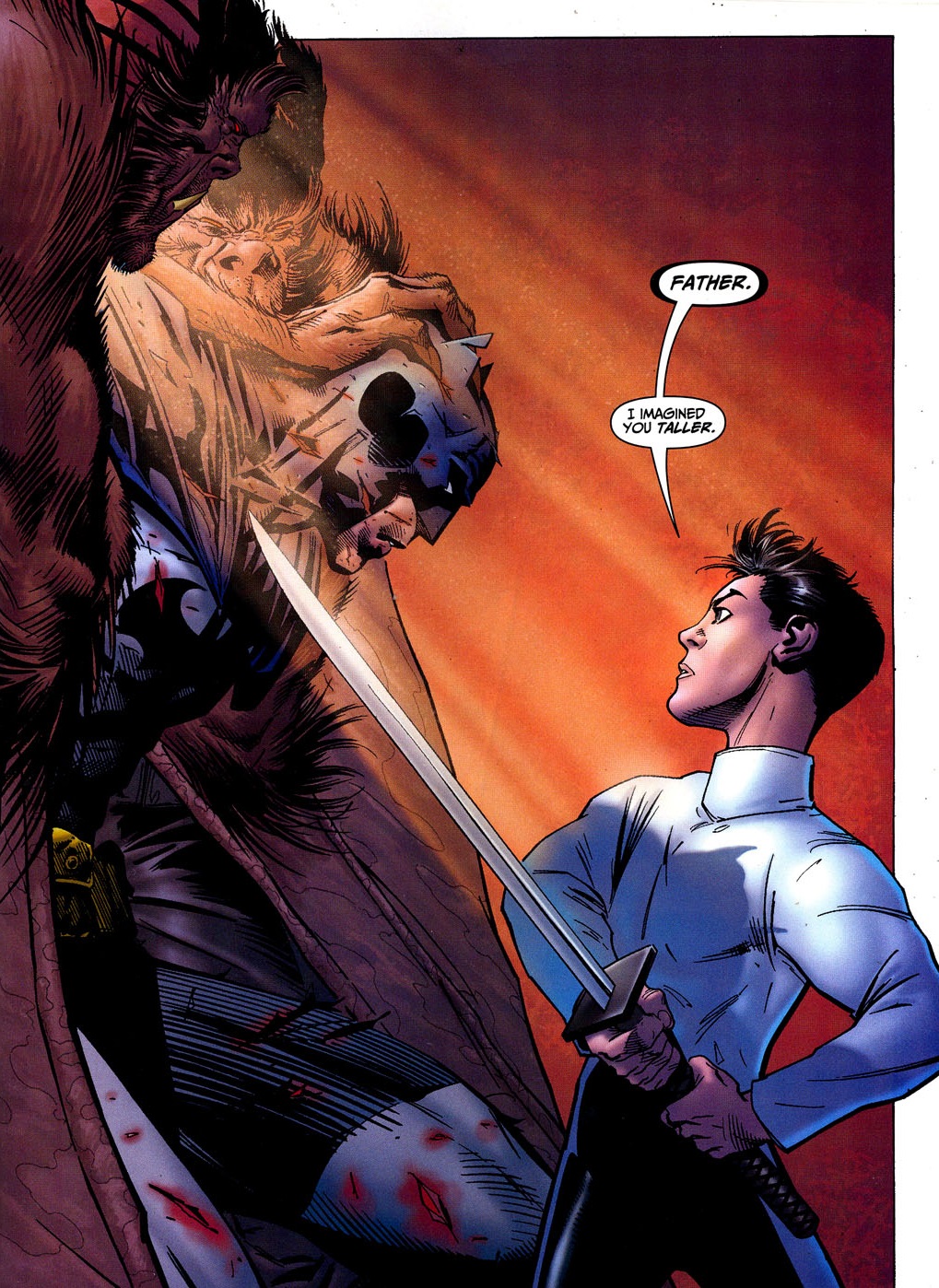
Grant Morrison’s radical seven-year run on Batman comics opened with a bang: its first story-arc turned the Caped Crusader’s world upside down by introducing his son, Damian Wayne, a hilariously arrogant kid who was trained to be a master assassin (and who went on to become one of the best additions to the cast in ages). Besides proving his willingness to shake the general status quo, Morrison also cheerfully revised the tone of the whole line: since the end of NML, most Batman-related books had become increasingly somber, with a misanthropic Dark Knight acting almost like a villain in his own series, but Batman and Son presented a well-adjusted Bruce Wayne in a tale with shamelessly ludicrous concepts and several laugh-out-loud moments. The book also set the stage for Morrison’s later stunts, including Bruce’s death (in Batman R.I.P. and Final Crisis), the replacement of the Dynamic Duo (Batman and Robin), Bruce’s time-travelling saga (The Return of Bruce Wayne), and the expansion of the Caped Crusader into an international franchise (Batman Incorporated).
20.‘The Court of Owls’ (Batman (v2) #1-11, cover-dated November 2011-September 2012), by Scott Snyder, James Tynion IV (script), Greg Capullo, Rafael Albuquerque (pencils), Jonathan Glapion, Rafael Albuquerque (inks), FCO Plascencia, Nathan Fairbairn, Dave McCaig (colors), Richard Starkings, Jimmy Betancourt, Patrick Brosseau, Dezi Sienty (letters)
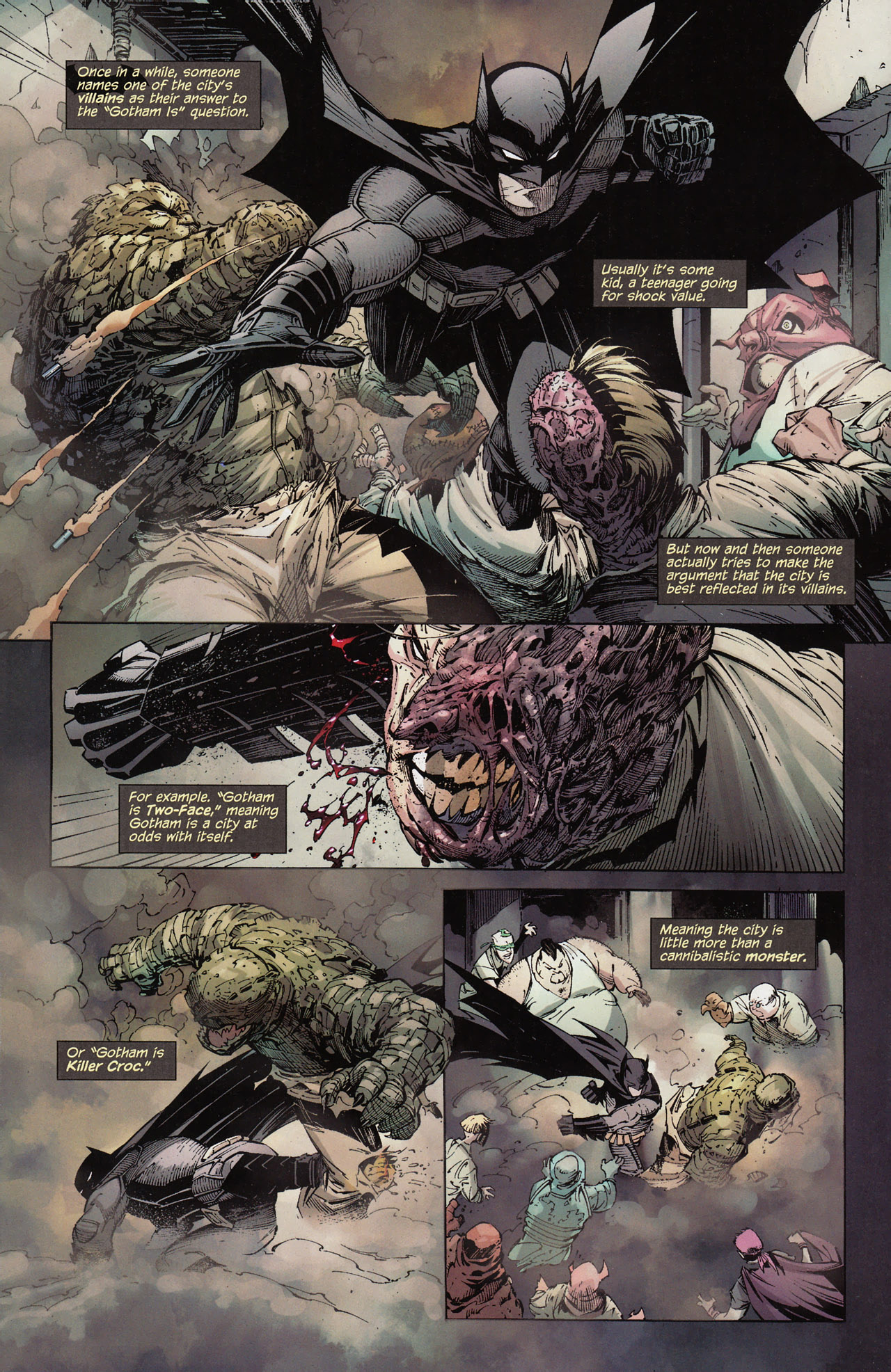
The last few years of Batman comics have been marked by so many surprising twists and changes in direction that stunts have become the new norm. This accelerated tendency goes back to Grant Morrison’s run, but many recent fans seem to have jumped on board with the so-called ‘New 52’ reboot, when Scott Snyder and Greg Capullo took over the main Batman series. Snyder has loosely recycled ideas from the last eight decades of stories, but he has done so in a particularly appealing way: whereas with Morrison the intertextual connections were a big part of the fun, in Snyder’s work readers don’t feel like they are necessarily missing much if they’re not aware of Batman’s long publication history. Add to this a horror-tinged flair for shock value and Capullo’s cartoony, dynamic pencils and you’ve got yourself a hugely successful take on this property. There are other starting points, for sure, but the first Snyder-Capullo collaboration, ‘The Court of Owls,’ laid the groundwork for what was to come both in terms of plot and of general approach to storytelling.
Honorable mentions (post-Crisis): Some comics have acquired enough of a lasting following and/or critical acclaim to deserve attention from any self-respecting Batman fan, even if they weren’t as influential as the ones listed above… It’s the case of Mike W. Barr’s and Alan Davis’ run in Detective Comics (#569-574, December 1986-May 1987), the graphic novel Son of the Demon (December 1987), Alan Grant’s and Norm Breyfogle’s run in Detective Comics (#583-594, 601-621, February-December 1988, June 1989-September 1990), the story-arc ‘Dark Knight, Dark City’ (Batman #452-454, August-September 1990), Kelley Puckett’s run in The Batman Adventures (#1-3, 6-30, October 1992-March 1995), the one-shot Mad Love (February 1994), the anthology Batman: Black and White (#1-4, June-September 1996), the story-arc ‘Hush’ (Batman #608-619, December 2002-November 2003), the mini-series Arkham Asylum: Living Hell (#1-6, July-December 2003), and the ongoing series Gotham Central (#1-40, February 2003-April 2006).
